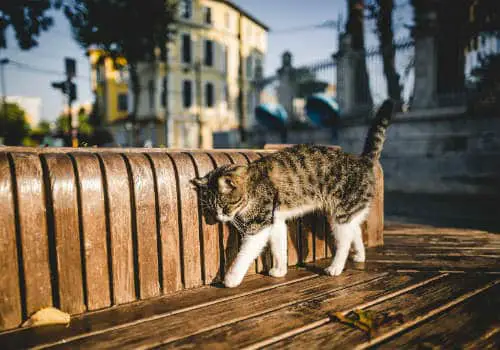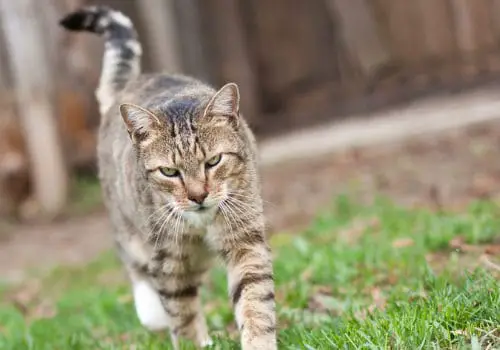A Leap to the Left: Why Do Cats Jump Sideways?
Updated: August 18, 2023
165
Cats, those enigmatic and graceful creatures that have captivated human hearts for centuries, never cease to amaze us with their unique behaviors and acrobatic feats. Among their repertoire of agile movements, the phenomenon of cats jumping sideways stands out as a particularly fascinating and perplexing behavior. This mesmerizing display of agility and precision has left cat owners and enthusiasts alike pondering the reasons behind this seemingly peculiar action.
The sight of a cat spontaneously launching itself into a sideways leap defies the laws of physics and gravity, captivating our attention and igniting curiosity. In their pursuit of toys, prey, or even just a fleeting moment of playfulness, cats often channel their boundless energy into these extraordinary lateral jumps. Observing a feline companion execute a flawless mid-air twist and landing with impeccable balance can leave us in awe of their innate athletic prowess.
One prevalent theory among animal behavior experts suggests that the sideways jump is an instinctual survival mechanism deeply rooted in a cat’s evolutionary history. In the wild, felines often find themselves in situations where sudden lateral movements are necessary to either evade predators or ambush prey. This behavior, honed over generations, allows cats to swiftly change direction and surprise their quarry, providing a tactical advantage in the hunt.
Furthermore, the sideways jump can also be attributed to a cat’s remarkable flexibility and impeccable coordination. Cats possess an extraordinary skeletal structure, with an exceptionally flexible spine and powerful muscles that enable them to contort their bodies in ways that seem almost otherworldly to us. This flexibility grants them the ability to adjust their trajectory mid-air, making the sideways leap a practical and efficient means of navigation in various environments.
As we delve deeper into the world of feline behavior, it becomes evident that the sideways jump is not merely a random act of whimsy. Instead, it serves as a testament to the harmonious fusion of instinct, physical prowess, and adaptability that cats have developed throughout their evolutionary journey. So, the next time you witness your furry companion executing a gravity-defying sideways jump, take a moment to marvel at the intricate tapestry of nature’s design that allows these graceful creatures to perform such astonishing feats.
The Secrets of Sideways Jumping in Cats

An Intimidating Posture
When cats perceive a threat, their innate response is to make themselves appear as imposing as possible. This strategy makes sense: larger entities tend to deter potential trouble, so by appearing bigger, a cat can decrease the likelihood of being confronted.
However, your feline friend might not boast the most imposing physique. Consequently, he must exert additional effort to magnify his presence in the face of danger.
Upon encountering a situation that demands a formidable presence, he initiates a series of maneuvers. First, he fluffs up his fur, concentrating on his back and tail. His spine’s fur stands upright, while his tail transforms into a bristle-like plume, reminiscent of a bottle brush.
Simultaneously, he adjusts his stance. Stretching out all four legs to their maximum extent, he elevates his posture, arching his back to create a noticeable elevation.
For an added boost in perceived size, he may even angle his body sideways toward the source of concern, leveraging perspective to enhance his apparent dimensions and project a more intimidating aura.
Although these behaviors are instinctual, they aren’t effortless. As we’ll soon discover, mastering the art of appearing large entails a rigorous training regimen that commences during kittenhood.
Sideways Jumping Starts in Kittenhood
Can there truly be a more blissful period in a cat’s life than the days of kittenhood? It’s an era marked by carefree abandon, where the primary pursuits involve growth and the acquisition of worldly wisdom.
Guided by the protective presence of their mother, kittens embark on a journey of exploration, delving into the mysteries of their environment and their own selves. Amid this delightful phase, a substantial portion of their time is devoted to frolicking and engaging in playful interactions with their littermates—a seemingly lighthearted endeavor that holds a deeper significance.
Play serves as the conduit through which kittens grasp the intricacies of cat social dynamics, mastering the art of communication, emotional expression, and adaptability. Engaging in playful encounters allows them to simulate real-life scenarios, preparing them to navigate encounters and challenges that lie ahead, from potential threats to confrontations with trespassers.
It is within the context of this joyful play that the enchanting spectacle of kittens fluffing up, arching their backs, and executing sideways jumps finds its purpose. These animated movements are, in essence, precursors to playful combat, a whimsical declaration of amicable intent. The sideways leap, when combined with these antics, becomes a signal of non-hostility—an embodiment of the paradoxical dance between appearing fierce and signaling goodwill.
Yet, let’s not overlook the sheer pleasure kittens derive from leaping alongside their fellow fuzzballs. What might otherwise be deemed a mundane exercise in perfecting the art of intimidation is artfully transformed into a gratifying play session, a means of channeling boundless kitten energy while fostering camaraderie.
While many kittens inevitably outgrow the sideways-jumping phase as the sands of time usher in maturity, there exist a select few feline individuals who retain this endearing behavior well into adulthood. The inquiry beckons: What precisely lies behind this prolonged leap into the playful past?
Adult Cats Can Jump Sideways, Too!

As your cat transitions into adulthood, a notable shift in temperament becomes evident. While the fondness for play endures, a sense of mellowness has settled in. The exuberant frolics and boisterous antics of kittenhood have given way to a more composed demeanor, accompanied by a heightened aptitude for conveying emotions through body language.
Although play remains a cherished pursuit, the frequency of energetic leaps and vigorous play-fighting has notably diminished. This transition is marked by a newfound self-assuredness, enabling your cat to communicate and express himself with a refined subtlety.
Hence, when his tail swells in size, accompanied by an arched back, it’s a clear signal that something is amiss. These physical changes convey a distinct message: a sense of threat or fear has enveloped him. It’s a prudent response to heed this warning; allowing him space and ensuring your presence doesn’t exacerbate his unease is likely the best course of action.
However, there’s a twist that often leaves you perplexed—the sideways jump. This unexpected move can trigger a surge of uncertainty. Is he harboring resentment towards you? Have you somehow managed to upset him to the point of launching an attack?
Fear not, for this sideways leap serves as the definitive clue that it’s all in good jest.
When cats genuinely sense danger, their reaction involves puffing up and arching their backs. Yet, a crucial distinction arises: they don’t execute sideways jumps towards the perceived threat. Instead, they stand their ground, accompanied by hissing, intense stares, and pinned-back ears.
In the absence of these unmistakable indicators, the odds are overwhelmingly in favor of your cat’s playful intentions, rather than aggression. The sideways jump toward you is a playful replication of the interactions he had while engaging in mock combat with his littermates. Embracing this display is advised—the most fitting response is to indulge his spirited mood.
Such a nostalgic return to kitten-like antics is relatively rare, making the experience all the more delightful. It stands as a testament to the trust he places in your ability to decipher his body language and engage with him on an intimate level.
Therefore, upon witnessing your feline friend’s sideways jump, seize the moment. Retrieve that enticing feathered toy or plush companion, and join in the revelry. Much like playtime once solidified bonds among siblings, it now holds the potential to deepen the connection between you and your cherished feline companion.
In Video
Why do cats jump sideways?
Cats often jump sideways as a playful behavior rooted in their kittenhood experiences. Sideways jumping, along with puffed-up fur and arched backs, is a precursor to play-fighting. It’s a way for cats to signal good intentions and engage in mock combat, practicing their social and defensive skills.
Is sideways jumping a sign of aggression in cats?
No, sideways jumping is not typically a sign of aggression in cats. When cats feel threatened or aggressive, they usually display other behaviors such as hissing, growling, and standing their ground. Sideways jumping is more likely a playful expression, reminiscent of their interactions with littermates during kittenhood.
Why do cats fluff up their tails and arch their backs when jumping sideways?
Fluffing up the tail and arching the back are part of the playful body language that cats exhibit during sideways jumps. These actions mimic the behaviors they use during play-fighting, helping them communicate their playful intent and imitate interactions with siblings.
Do all cats jump sideways?
While many kittens exhibit sideways jumping behaviors during play, not all cats continue to do so into adulthood. Most cats gradually outgrow this behavior as they mature. However, some cats may retain the habit, often as a way to engage in playful interactions with their human companions.
Is sideways jumping a cause for concern?
Generally, sideways jumping is not a cause for concern. It is often a harmless and playful behavior, especially in young cats and kittens. However, if you notice other signs of distress, aggression, or significant changes in your cat’s behavior, it’s a good idea to consult a veterinarian to rule out any underlying health issues.
Can I encourage sideways jumping in my cat?
While you can engage your cat in play and interactive activities, including using toys that encourage jumping and pouncing, it’s important to let sideways jumping occur naturally. It’s primarily a playful behavior that arises from the cat’s own instincts and experiences.
Conclusion
In the intricate tapestry of feline behavior, the captivating phenomenon of cats jumping sideways emerges as a testament to their evolutionary prowess and innate instincts. This dynamic maneuver, often accompanied by a fluffed-up tail and arched back, showcases the remarkable blend of playfulness, communication, and survival skills that define our enigmatic companions.
While the sideways jump might puzzle and intrigue us, its origins can be traced back to the playful interactions of kittens in their early stages of life. As siblings engage in mock combat, practicing both defense and offense, the sideways leap becomes a precursor to more mature behaviors. Through this animated display, cats convey intentions that are more about camaraderie than confrontation—a manifestation of trust and affection towards their human counterparts.
Please Write Your Comments